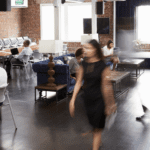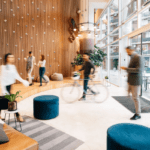Last week, leading design, architecture, engineering and planning firm HOK hosted a webinar featuring perspectives from HOK’s Director of WorkPlace Kay Sargent as well as our very own Erica Eaton, Chief of Strategy, who joined the conversation to discuss the role of technology in Returning to Work in a World of Heightened Sensitivity.
We caught up with Kay and Erica on some of the webinar’s key takeaways for you to put in your COVID-response toolkit.
Can you provide some background on why this webinar topic, Returning to Work in a World of Heightened Sensitivity, is important right now?
Kay: HOK has been researching neurodiversity in the workplace for quite a while and published a series of reports to share insights into how organizations can rethink their space to be more inclusive and help an increasingly neurodiverse workforce thrive. This is especially relevant now, as there is a direct connection between our research into the needs of neurodivergents and their heightened sensitivities to stimulation and what many people are experiencing as a result of COVID-19.
What specifically do we expect employees to have heightened sensitivities towards?
Kay: In addition to shifting the way we work, COVID-19 has changed how we interact with people and the physical environment. Today we distance ourselves from others, wear gloves and masks, and sanitize anything that infiltrates our personal space. As a result of the pandemic, we expect that both tactile and proprioceptive sensitivities will be heightened, specifically, tactile sensitivities stemming from a fear of touch and proprioceptive sensitivities rooted in concern over range, motion, and physical distance between individuals and their environment.
What are some operational measures clients can be taking right now to ensure we’re still prioritizing inclusivity, mental health, safety, and wellbeing outside of the office?
Kay: Start with making sure you have a culture of support. These are difficult, uncomfortable, and uncertain times that require heightened awareness about mental health, safety, and wellbeing. The best place to start is with communication, and ensuring that all employees feel informed and connected. Solicit feedback from employees and assess what’s working and what isn’t. Ensure that all groups and functional levels are addressed in the distributed work program and that everyone has access to the tools they need to do their best work. Improve your existing internal communication channels to keep employees informed.
How can Comfy be used to keep employees informed during this time?
Erica: Before COVID-19, Comfy worked with global clients to ensure the centralization of corporate communications, services, and amenities. Today, our solutions have become increasingly relevant through a new lens: centralizing the latest COVID-19 information and communications to support health and safety programs.
In a time of rapidly changing information and hyperlocal mandates, it’s critical that employees have a single place they can go to find the most helpful information from their employer. We find that meeting employees where they are—i.e., a centralized mobile app used at home or the office—improves communication channels while fostering greater transparency.
There’s been a lot of debate as to whether COVID-19 will encourage corporations to retreat back to assigned seating and partitioned walls (or be a temporary consideration for workplace design). What’s your perspective?
Kay: As Albert Einstein once said, “In the midst of every crisis, lies great opportunity.”
We know that employees want choices about where and how they work. The rise of health and safety concerns will only increase this desire. Introducing ‘sneeze guards’ or other partitions alone will not truly address the problem. In fact, this actually introduces additional surfaces that must be cleaned. While there are many considerations, we see this as an opportunity to catapult workplace design forward, encompassing new ways of working, technology, and thinking about why and when we come to the office.
Comfy is working with clients right now on strategizing a safe re-entry to the office. What are some initiatives HOK is considering for re-entry planning?
Kay: When we started thinking about re-entry, we turned back to our research into the needs of neurodivergent employees and their sensitives to stimulation. COVID-19 will likely heighten tactile and proprioceptive sensitivities for all employees, and we’ll need to incorporate these ideas into strategies for a safe re-entry.
This is an evolving situation. Organizations must follow the health and safety guidelines and advice of public health specialists and be willing to adjust as this goes on. But we can offer some considerations for a potential re-entry plan:
- Be careful not to remove all social connectivity as part of physical distancing strategies.
Use design elements to define zones to aid in both spacing and creating a sense of belonging, like neighborhood-based choice environments. Many people miss that sense of human connection while working from home, but may be fearful as they return and attempt to navigate new social workplace norms. Lead your organization through this by ensuring the space feels welcoming and that the enhanced distancing and sanitization procedures don’t make it feel overly sterile. - Reassess your work points.
Transition to unassigned seating to allow employees to establish their own boundaries and pick seats that enable distancing and their best work. Incorporate elements of the ‘prospect-refuge theory’ and ensure either clear lines of sight or real-time ability to view and assess areas for potential retreat. Remove obstacles to choices by expanding spacing between seats to a minimum of six feet—more, if possible—and create clean desk/conference room policies that require surfaces to be cleaned daily. - Ensure distancing in passage and gathering.
Remove navigation friction points by encouraging one-way circulation patterns and by ensuring that passageways enable generous spacing and remove accidental contact at blind corners. If spaces have multiple doors, create separate entries and exits where possible. For gathering areas, remove some seats from around tables to give people more space and focus on enabling meaningful interaction. - Embed well-being measures into building operations.
Work with building management to improve air circulation, filtration, and ventilation. Increase hand washing opportunities outside of restrooms, and introduce sanitation stations across the space. And implement automation, voice activation, or hands-free controls in order to limit the need to touch commonly used items. - Ensure continuity.
This one is difficult, as there will likely be a wide range of new programs, policies, and procedures. Our recommendation is to monitor utilization and use patterns and make adjustments where needed while keeping the mindset of designing spaces that bring us together, while keeping us apart. - Leverage technology.
Technology will be a valuable asset for both employees and workplace teams during this new phase of work. Sensor technology connected to booking systems can help you block out seating to ensure spacing, identify available work points, and monitor office density. This technology also can drive usage-based cleaning schedules and block spaces that have been used but not cleaned.
Speaking of technology, how do you see it being leveraged to support both employees and employers through this period of heightened sensitivity?
Erica: Comfy has always been focused on improving the workplace experience—getting employees what they need, when and where they need it. In response to COVID-19, we are leveraging existing functionality to support the return to the workplace and enable the health and safety programs that organizations are putting in place.
Some examples include educating employees on clean desk policies, supporting physical distancing through configurable desk and room booking, preventing amenity overcrowding through real-time occupancy viewing, or helping colleagues find each other—whether they are in the office or working from home. For employers, Comfy will continue to recommend best practices for monitoring office occupancy and density, allowing for safe distancing and re-entry decisions at the floor, building, and portfolio levels.
Interested in hearing more perspectives on the transition back to work? Watch Comfy’s recent webinar.
For more COVID-19 workplace resources, view Comfy’s Return to Workplace Playbook.



